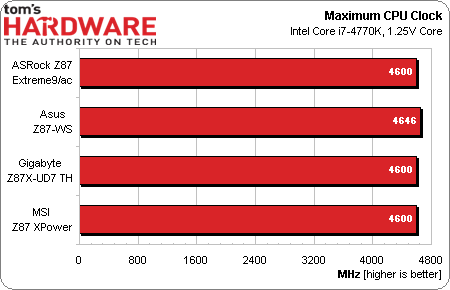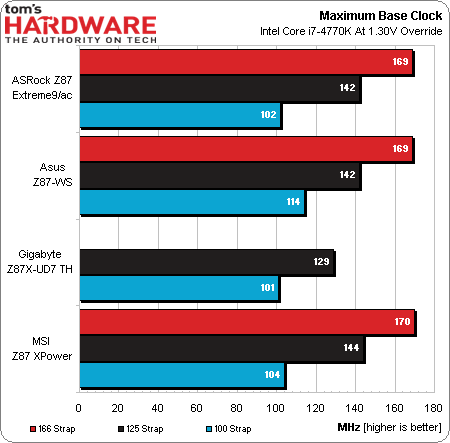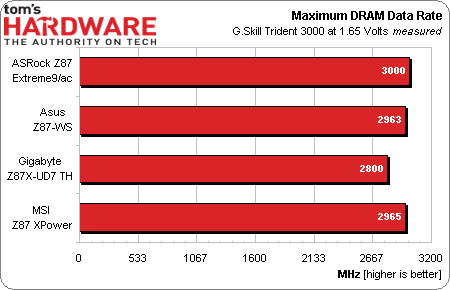Four Z87 Express Motherboards For Three- And Four-Way SLI
Formerly a very exclusive component, the PCI Express switch that makes Intel’s LGA 1150-based platforms three- and four-way SLI-capable is now available across a range of high-end motherboards. Today we compare four premium enthusiast-oriented models.
Overclocking Results
Why you can trust Tom's Hardware
| BIOS Frequency and Voltage settings (for overclocking) | ||||
|---|---|---|---|---|
| Row 0 - Cell 0 | ASRock Z87 Extreme9/ac | Asus Z87-WS | Gigabyte Z87X-UD7 TH | MSI Z87 XPower |
| Base Clock | 90-300 MHz (0.1 MHz) | 80-300 MHz (0.1 MHz) | 80-267 MHz (0.01 MHz) | 90-300 MHz (0.06 MHz) |
| CPU Multiplier | 8.0-120x (1x) | 8.0-80x (1x) | 8-80x (1x) | 8-80x (1x) |
| DRAM Data Rates | 800-4000 (200/266.6 MHz) | 800-3200 (200/266.6 MHz) | 800-2933 (200/266.6 MHz) | 800-3200 (200/266.6 MHz) |
| CPU Vcore | 0.80-2.00 V (1 mV) | 0.001-1.92 V (1 mV) | 0.50-1.80 V (1 mV) | 0.80-2.10V (1 mV) |
| VCCIN | 1.20-2.30 V (10 mV) | 0.80-2.70 V (10 mV) | 1.00-2.91V (10 mV) | 1.20-2.30 V (1 mV) |
| PCH Voltage | 0.98-1.32 V (5 mV) | 0.70-1.80 V (6.25 mV) | 0.65-1.30 V (5 mV) | 0.70-1.80 V (10 mV) |
| DRAM Voltage | 1.17-1.80 V (5 mV) | 1.2-1.92 V (5 mV) | 1.15-2.10 V (5 mV) | 1.20-2.40 V (10 mV) |
| CAS Latency | 4-15 Cycles | 1-31 Cycles | 5-15 Cycles | 4-15 Cycles |
| tRCD | 3-20 Cycles | 1-31 Cycles | 4-31 Cycles | 4-31 Cycles |
| tRP | 4-15 Cycles | 1-31 Cycles | 4-31 Cycles | 4-31 Cycles |
| tRAS | 9-63 Cycles | 1-63 Cycles | 5-63 Cycles | 9-63 Cycles |
Some manufacturers happen upon their overclocking victories by tampering with set voltage levels, sneaking in 20 to 30 millivolts more than you specify. But we usually catch that, either by voltmeter or by CPU temperature (often both). We weren’t surprised that three of the boards hit exactly the same overclock, and only one of these allowed us to bump up base clock by a measly 1 MHz at 46x.
Speaking of base clock, the most significant setting for users with multiplier-locked processors is at the 100 MHz strap. That’s because both ratio adjustment and base clock strap are locked out of those same CPUs. Certain manufacturers have ways to boost base clock overclocking capability, included reductions in System Agent/Cache and integrated GPU ratios. We left those settings to the manufacture to choose, and Asus surprised us with a 114 MHz BCLK.
ASRock and Gigabyte experienced the same phenomena seen by EVGA in our mini-ITX motherboard round-up, where increased base clock caused the PCIe graphics card to malfunction. I’m starting to wonder if it’s a problem with Intel’s latest base firmware, which companies can modify to suit their board’s configuration differences.
We used our voltmeter to set 1.650 to 1.655 volts to the memory
Current page: Overclocking Results
Prev Page Power, Heat, And Efficiency Next Page Which Premium Z87 Motherboard Takes Top Honors?Get Tom's Hardware's best news and in-depth reviews, straight to your inbox.
-
iam2thecrowe Am i missing something here? I dont see the point of reviewing 3 and 4 way sli boards and not testing 3 and 4 way sli. Seems rather pointless since any average motherboard will perform well in adobe, productivity etc benches dependent on the cpu....Reply -
Crashman This was really just about finding any board that supports Nvidia's requirements about how that third card is connected. We found some, I overclocked them, now I have enough data to pick a board for the System Builder Marathon. But that only explains why overclocking took priority!Reply
After spending two days per board on a "one week" article, I couldn't add more tests. The general benchmark set looks for unintended overclocking/underclocking, power and memory bandwidth issues, so you can see the performance difference attributable to each board's CPU and DRAM configuration differences. It runs from a .bat file, so it didn't add significantly to the article's completion time.
The PLX bridge that these all share represents the "great equalizer" when it comes to CrossFire and SLI configuration, so that portion of all three boards should be identical. I understand that things that should be the same in theory are occasionally different in practice. My apologies for not having the extra 1-day per board for additional tests. -
iam2thecrowe Reply12341788 said:They all use the same PLX bridge, so you would have seen a whole bunch of identical gaming results. The general benchmark set looks for unintended overclocking/underlocking, power and memory bandwidth issues, so you can see the actual performance difference. And there's still an overclocking section.
These boards had to be tested for general performance and stability like any other boards. The PLX controller is the equalizer when it comes to games.
I think testing 3/4 way sli would still be valid, as it doesn't always work properly, in the past there have been compatibility problems with certain gpu's/boards/firmware/controllers and certain benchmarks completely failed. -
Kraszmyl "internally-mounted external USB 2.0 port for ReadyBoost fanatics" on the asus z87.Reply
Those have nothing to do with readyboost. The internal usb ports are very common on workstations and you put CAD dongles and equivalent items in them so that you can lock them inside the case and don't have to worry about some one stealing them from the outside or them taking up an outside usb port. -
Memnarchon I would love to see Asus Maximus VI Extreme, but it seems ASUS didn't want to give a 2nd board and prefered the Z87 WS....Reply -
Traciatim where are the sli/crossfire benchmarks and comparisons with traditional non-switched setups?Reply
Hey guys, we have these awesome new setups for supreme graphics pumping power! Watch it zip files like every other board! -
duramax08 Why are they still making motherboards with PS/2 connections? Its time to move on, replace those baby's with some USB 3.0!Reply



